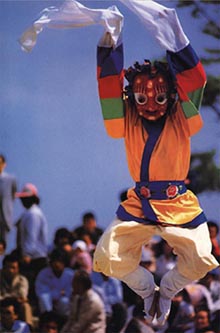 Like the Kangnyong Mask Dance, the Bongsan Mask Dance Like the Kangnyong Mask Dance, the Bongsan Mask Dance
is from Hwanghae Province. It was usually performed at rural markets,
which opened every five days at large towns and villages around
the country.
In the course of a year, performers played almost
every five-day market in the country. Bongsan was an important
distribution center for agricultural and fishery products,
so it provided fertile ground for the development and perpetuation
of mask dance-drama.
Traditionally the dance-drama was performed
on the Buddha's Birthday, as was Yangju Byolsandae-nori in Gyonggi
Province, but toward the end of the Joseon Dynasty, it was performed
through the night around a bonfire at the Dano Festival in the fifth
lunar month. Thus what originally was a religious ritual gradually
became a form of entertainment.
Unlike
Yangju Byolsandae-nori, the mask dance-dramas of northern Korea
were not generally patronized by the government elite. Most catered
to farmers and merchants.
Bongsan Mask Dance follows the story
line presented in Yangju Pyolsandae-nori but it features more dancing
and different songs. The dance-drama was originally performed
by men alone, but after the 1920s female entertainers took the women's
roles. A total of 28 masks are used.
  
|